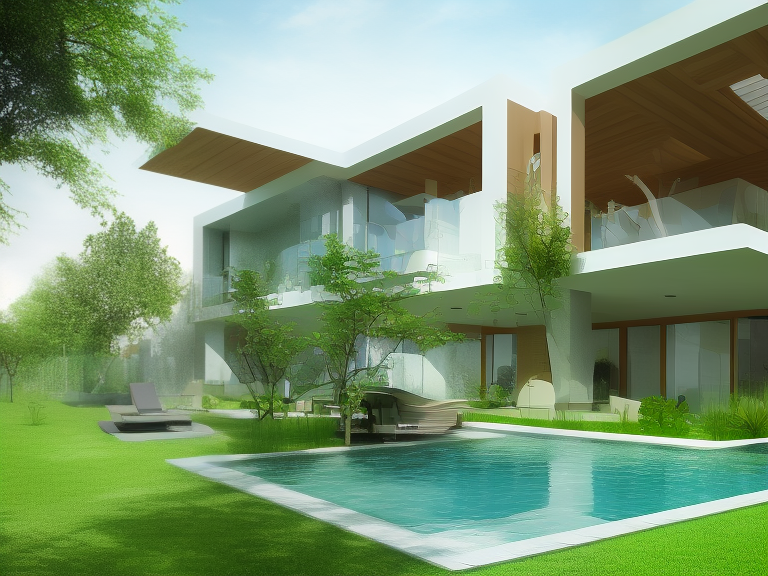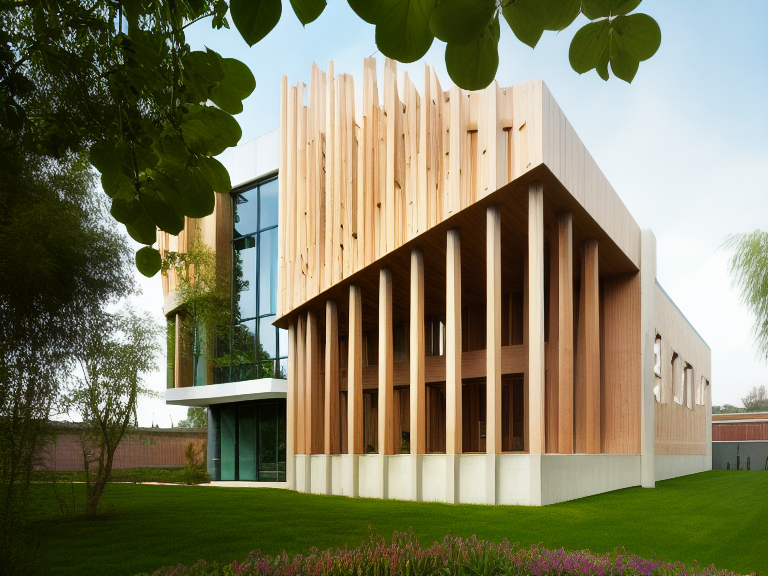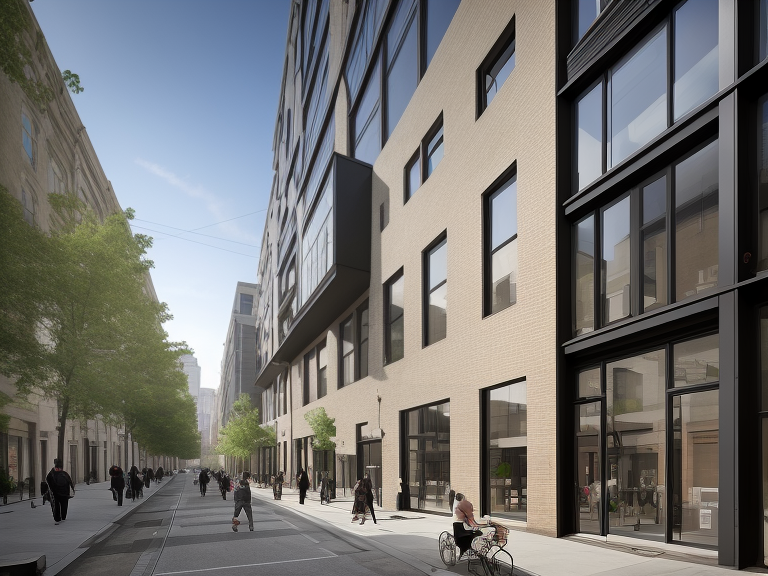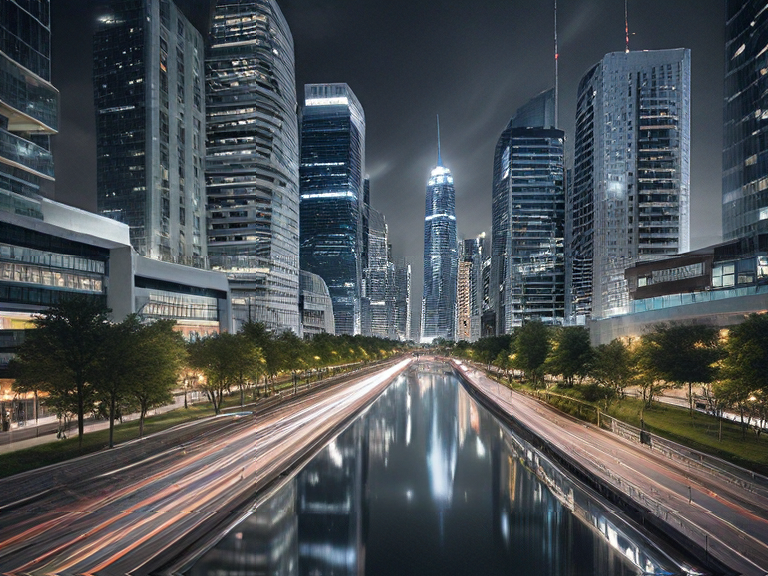Sustainable architecture revolutionizes the built environment by integrating eco-friendly design principles, materials, and energy-efficient systems. Prioritizing harmony with nature, it enhances occupant well-being, productivity, and cognitive function. Energy efficiency strategies, such as insulation, energy audits, and biophilic design, minimize ecological footprints. Innovative water conservation techniques and sustainable materials reduce environmental impact. By incorporating natural ventilation strategies, air quality control systems, and healthy material selection, buildings can achieve net zero energy status. As we forge a path towards a sustainable future, the possibilities for innovative, eco-conscious design unfold, beckoning us to explore the vast potential of sustainable architecture.
Green Building Design Principles
Fundamentally, green building design principles prioritize the harmonious integration of a structure with its surroundings, ensuring that the built environment minimizes its ecological footprint. This approach not only reduces the environmental impact of buildings but also enhances the well-being of occupants. One key aspect of green building design is the incorporation of biophilic spaces, which aim to reconnect humans with nature. By incorporating natural elements, such as plants, natural light, and ventilation, these spaces promote physical and mental health. Additionally, biophilic design has been shown to increase productivity, cognitive function, and overall job satisfaction.
Urban forestry is another essential element of green building design principles. This concept involves integrating trees and vegetation into urban planning, providing numerous benefits including air quality improvement, noise reduction, and microclimate regulation. Urban forestry also helps to mitigate the urban heat island effect, reducing the need for air conditioning and improving overall energy efficiency. By incorporating green roofs, green walls, and urban parks, buildings can become an integral part of the ecosystem, rather than a disruption to it. By adopting green building design principles, architects and builders can create structures that not only minimize their environmental impact but also promote the health, well-being, and productivity of occupants.
Energy Efficiency Strategies
How can buildings be designed to consume fewer resources while maintaining a comfortable indoor environment, and what strategies can architects and builders employ to minimize energy waste and reduce their carbon footprint? One important approach is to optimize building insulation, ensuring that the structure's envelope is well-insulated to prevent heat loss and gain. This can be achieved through the use of advanced materials and innovative construction techniques. By minimizing air leaks and thermal bridges, buildings can maintain a consistent indoor climate, reducing the need for excessive heating and cooling.
Another essential strategy is to conduct thorough energy audits to identify areas of energy inefficiency. These audits involve a detailed assessment of a building's energy consumption, pinpointing opportunities for improvement and providing a roadmap for energy-saving retrofits. By identifying and addressing energy-wasting systems and components, architects and builders can implement targeted upgrades, such as installing energy-efficient lighting and HVAC systems, to reduce energy consumption and greenhouse gas emissions.
Sustainable Materials and Resources
Integrating sustainable materials and resources into building design is essential for reducing the environmental impact of construction, as the extraction, processing, and transportation of materials account for a substantial portion of a building's carbon footprint. The thoughtful selection of materials can greatly mitigate the ecological consequences of construction, from the harvesting of raw materials to the disposal of waste.
One innovative approach is the incorporation of recycled aggregates, which can replace virgin materials in construction. This not only reduces waste but also conserves natural resources, decreasing the demand on quarries and minimizing the energy required for processing. Additionally, utilizing locally sourced materials reduces transportation emissions, supporting local economies and promoting regional sustainability.
In addition to recycled aggregates, designers can explore alternative materials that sequester carbon, such as engineered wood products or low-carbon concrete. By specifying materials with lower embodied energy, architects can minimize the environmental burden of their designs. By adopting a holistic approach to material selection, sustainable architects can create buildings that not only minimize environmental harm but also promote ecological balance and social responsibility. As the built environment continues to evolve, the careful consideration of sustainable materials and resources will play a crucial role in shaping a more resilient and sustainable future.
Water Conservation Techniques
As the world grapples with the challenges of water scarcity, architects and builders are turning to innovative water conservation techniques to reduce the environmental footprint of buildings. One of the most effective strategies is the implementation of rainwater harvesting systems, which collect and store rainwater for non-potable uses. Additionally, grey water reuse methods and the installation of efficient fixtures and fittings can greatly reduce water consumption, creating a more sustainable built environment.
Rainwater Harvesting Systems
Rainwater harvesting systems, an essential component of sustainable architecture, offer a reliable means of supplementing traditional water supplies and reducing the strain on municipal water resources. By collecting and storing rainwater, buildings can decrease their reliance on potable water for non-potable uses such as flushing toilets, irrigating landscapes, and washing vehicles. Effective stormwater management is critical in rainwater harvesting, as it prevents water pollution and reduces the burden on drainage infrastructure. Rooftop collection is a popular method, where rainwater is channeled from the rooftop to a storage tank for later use. This approach not only conserves water but also decreases the urban runoff that can carry pollutants into waterways. Implementing rainwater harvesting systems in buildings can notably reduce the demand on municipal water supplies, mitigate the risk of water scarcity, and contribute to a more sustainable future. By integrating rainwater harvesting into building design, architects can create more resilient, eco-friendly, and sustainable structures that benefit both the environment and the community.
Grey Water Reuse Methods
Grey water reuse methods, an integral component of water conservation techniques, involve the collection, treatment, and reuse of wastewater generated from sinks, showers, and washing machines for irrigation, toilet flushing, and other non-potable purposes. This innovative approach not only reduces the demand on potable water supplies but also decreases the amount of wastewater discharged into sewage systems. Effective grey water reuse methods rely on efficient wastewater treatment systems that can remove contaminants and pollutants, making the water safe for reuse. In urban planning, incorporating grey water reuse systems can greatly reduce the strain on municipal water supplies, alleviating pressure on infrastructure and mitigating the risk of water scarcity. By adopting grey water reuse methods, architects and urban planners can create sustainable and resilient urban environments that prioritize water conservation and efficiency. As the global water crisis continues to intensify, embracing grey water reuse methods will be essential in building a more sustainable future.
Efficient Fixtures and Fittings
Architects and builders can greatly reduce water consumption by specifying efficient fixtures and fittings, such as low-flow showerheads and toilets, which offer a simple yet effective way to conserve this precious resource. By incorporating innovative technologies, buildings can minimize their environmental footprint and optimize water usage. Smart Toilets, for instance, utilize advanced sensors and algorithms to detect and adjust water flow, ensuring the best amount of water is used for each flush. Additionally, Low Flow Faucets with aerators or flow restrictors can reduce water flow rates while maintaining a satisfying user experience.
These efficient fixtures and fittings not only conserve water but also reduce energy consumption and lower utility bills. Moreover, they can be integrated with grey water reuse systems to create a holistic water management strategy. By adopting these sustainable solutions, architects and builders can create buildings that not only minimize their environmental impact but also provide a healthier, more comfortable, and more sustainable indoor environment for occupants. By specifying efficient fixtures and fittings, architects and builders can play an important role in shaping a more sustainable future.
Indoor Environmental Quality
As we shift our focus to indoor environmental quality, we explore the critical aspects that directly impact occupant health and wellbeing. Effective air quality control systems, strategic natural ventilation strategies, and the thoughtful selection of healthy materials are essential considerations in creating interior spaces that promote occupant comfort and productivity. By integrating these elements, architects and designers can craft indoor environments that not only support the wellbeing of building occupants but also contribute to a more sustainable future.
Air Quality Control Systems
Effective air quality control systems are essential in maintaining a healthy indoor environment, as they remove pollutants and contaminants, ensuring a safe and comfortable space for occupants. A critical component of air quality control systems is air purification, which involves the removal of airborne pollutants, allergens, and irritants. This can be achieved through the use of air filters, which capture particles as small as 0.3 microns, and advanced technologies such as UV light purification. In addition to air purification, ventilation systems also play an important role in maintaining indoor air quality. These systems work to exchange stale air for fresh air, reducing the concentration of pollutants and CO2. Ventilation systems can be designed to optimize airflow, reduce energy consumption, and minimize the introduction of outdoor pollutants. By integrating air purification and ventilation systems, sustainable buildings can provide a healthy and comfortable indoor environment, while also reducing the environmental impact of traditional HVAC systems.
Natural Ventilation Strategies
In addition to mechanical ventilation systems, natural ventilation strategies can be employed to further enhance indoor environmental quality by harnessing natural airflow and reducing the need for mechanical cooling and heating. This approach not only improves air quality but also reduces energy consumption, aligning with sustainable architecture principles.
Natural ventilation strategies can be categorized into three types: wind-driven, buoyancy-driven, and stack-driven ventilation. The Stack Effect, which occurs when warm air rises, can be leveraged to create natural convection currents. Wind Towers, a design feature that enhances wind-driven ventilation, can be integrated into building design to amplify airflow.
| Ventilation Type | Description | Benefits |
|---|---|---|
| Wind-Driven | Utilizes wind pressure to drive airflow | Reduces energy consumption |
| Buoyancy-Driven | Leverages density differences to create airflow | Improves indoor air quality |
| Stack-Driven | Harnesses the Stack Effect to create convection currents | Enhances natural ventilation |
Healthy Material Selection
What role do building materials play in shaping the indoor environmental quality, and how can informed selections mitigate adverse impacts on occupant health and well-being? The answer lies in healthy material selection, an important aspect of sustainable architecture. The materials used in building construction can greatly influence indoor air quality, which in turn affects the health and productivity of occupants. Informed material selection is essential to ensuring a healthy indoor environment.
Material transparency is key in making informed decisions. By understanding the chemical composition of materials, architects and builders can avoid using products that emit volatile organic compounds (VOCs) or other harmful substances. Supply chain ethics also play an important role in healthy material selection. Ensuring that materials are sourced from sustainable and responsible suppliers can mitigate the environmental and social impacts associated with material extraction and processing.
Net Zero Energy Buildings
Rigorously designed and operated, net zero energy buildings have become a beacon of sustainability in the built environment, producing as much energy as they consume on an annual basis. These buildings have revolutionized the way we think about energy consumption, minimizing their reliance on the grid and reducing their carbon footprint through innovative technologies and design strategies.
To achieve net zero energy status, buildings must incorporate various techniques, such as ideal building orientation, energy-efficient systems, and on-site renewable energy generation. Energy storage systems, like batteries, play a vital role in storing excess energy generated during the day for use during periods of high demand. Load shedding and peak shaving strategies also help reduce energy consumption during peak hours, alleviating pressure on the grid and promoting grid resilience.
In addition, net zero energy buildings can engage in energy trading, selling excess energy back to the grid and offsetting energy consumption through carbon offsetting. Microgrids and community energy systems enable buildings to share energy resources, promoting a more decentralized and resilient energy infrastructure. By integrating these innovative technologies and design strategies, net zero energy buildings have become a model for sustainable development, paving the way for a more environmentally conscious built environment.
Frequently Asked Questions
Can Sustainable Architecture Be Applied to Historic Building Renovations?
As the ancient Greeks once eloquently stated, "the whole is more than the sum of its parts." Similarly, when it comes to historic building renovations, sustainable architecture can indeed be applied, but it requires a delicate Preservation Balance. By striking a balance between Heritage Integration and modern sustainability, we can breathe new life into aged structures while preserving their timeless charm.
How Do I Measure the Sustainability of a Building Project?
Measuring the sustainability of a building project requires a multifaceted approach. Energy auditing is essential to identify areas of inefficiency and opportunity for improvement. Carbon footprinting is also vital, as it quantifies the project's environmental impact. By integrating these assessments, developers can optimize building performance, reduce emissions, and create environmentally conscious spaces. This holistic evaluation enables data-driven decision-making, ensuring that sustainable design principles are effectively implemented and monitored throughout the project's lifecycle.
What Are the Benefits of Hiring a Sustainable Architect?
When initiating a building project, hiring a sustainable architect can have a profound impact. A seasoned sustainable architect brings expertise in energy efficiency, ensuring that the building’s design and systems work in harmony to minimize energy consumption. This not only reduces operational costs but also supports environmental stewardship. By integrating sustainable principles, architects can create buildings that not only benefit the environment but also enhance the well-being of occupants, ultimately resulting in a more responsible and forward-thinking built environment. Additionally, sustainable architects incorporate innovative materials and technologies that align with future visions in architecture, promoting resilience and adaptability in building design. Their approach ensures that structures remain efficient and environmentally responsible for years to come, meeting both current and anticipated sustainability standards. By embracing these forward-thinking strategies, architects contribute to a built environment that harmonizes with both nature and human needs.
Can Sustainable Architecture Be Achieved on a Limited Budget?
Achieving sustainable architecture on a limited budget is indeed possible. By incorporating budget-friendly materials and cost-effective design strategies, eco-friendly buildings can be constructed without breaking the bank. For instance, using reclaimed wood, low-VOC paints, and energy-efficient systems can greatly reduce costs while maintaining environmental stewardship. Additionally, designing with natural light and ventilation in mind can minimize the need for artificial lighting and heating, resulting in long-term savings.
Are There Any Certifications for Sustainable Architecture Professionals?
In the pursuit of sustainable architecture, professionals can demonstrate their expertise through certifications. Consider the example of Emma, a architect who earned her LEED Accreditation, showcasing her proficiency in green building practices. Similarly, the Green Badges program recognizes professionals who have completed a rigorous training program in sustainable design. These certifications not only enhance one's reputation but also contribute to a more environmentally conscious built environment.



